SDS Labs Amplifiers
SDS Labs EL84 Push Pull Amp
I designed this little amp before I got the Fisher. It's a neat little design. I haven't done too much in the way of optimization, or tweaking, but it sounds pretty good as is.
![]() EL84 Push-Pull amp Great
For Quad ESLs!
EL84 Push-Pull amp Great
For Quad ESLs!
![]() EL84 Amp Circuit Board Layout
EL84 Amp Circuit Board Layout
SDS Labs Headphone Amp (solid state)
This little headphone amp uses a push-pull Class A MOSFET output stage, being driven by an op-amp. The output stage is included in the op-amp feedback loop, so the distortion figures are amazingly low. The power supply uses a 25 watt torroid transformer, and two adjustable regulators. It sounds very good; suprisingly un-solid state.
![]() Headphone amp article preview.
Headphone amp article preview.
Headphone Amp Photo 1
Headphone Amp Photo 2
Dyna ST-70 Amp (And the SDS Labs input board)

This classic tube amplifier used to be the best value on the block. Ten years ago you could buy one of these for $25. This amp was designed to be inexpensive and to get maximum performance for dollar paid. At the end of it's sale it sold for about $100 in kit form. David Hafler, the amp designer, made the cost containing compromises in a very clever way. For example, the power supply is wimpy by modern standards, but he biased the output tubes into Class A, so the current demands on the power supply are fairly constant regardless of program material. The input section is very simple; an input pentode, followed by a direct coupled split load inverter based on a triode. This topology was very popular at the time, and used the 7199 tube. There is an outer feedback loop that encloses the output transformer and input pentode. There is also a secondary feedback loop that is taken from the ultra-linear screen tap. Even with these two feedback loops, this amplifier very stable. From my measurements and listening tests, I believe that the Dyna ST-70 output transformers are of very good quality (at least the ones on my ST-70).
There are many modifications available for this amp. There are two problems that most modifications fall into. First there are the total mods. Basically, everything in the amp is removed except the iron, and the amp is rebuilt. This is all well and good, but don't forget that this is a budget amp, and the chassis is not so great either. If you are going to dump that much money into a tube amp, why not start with a new chassis, and design it from the ground up instead of making compromises to fit the mod into this chassis. The second type of modification class is just to replace the input board which contains the poor sounding and hard to find 7199 tubes. This can be a good way to go, but if the topology is changed significantly, the stability of the amp can be compromised. And if the original design is changed in one way, it can show the compromises in another area. For example, if the bias current is reduced on the output tubes to lengthen their lives, the power supply modulates more with the musical signal, and the IMD goes through the roof.
Based on my listening experience with various ST-70 mods. The most satisfying mods change the amp the least. These mods have kept the pentode voltage amp followed by a triode split load inverter. Changing the 7199 tube to a 6GN8 TV tube is popular, and requires socket repining. But triode/pentode tubes generally don't sound all that good, I believe that is because only the 7199 was really designed for audio. The other method is to use a third tube, and use two pentodes and a dual triode. This method allows the use of readily available, good sounding tubes. Triode Electronics used to sell a new input board based on this technique, but is no longer available. It was based in a pair of EF86 Pentodes, and either a 12AU7, or 12BH7 dual triode. I have redrawn their board (without thier permission of course), and I am offering it here. I am also providing a version that uses a 6AU6 pentode instead of the getting rare EF86.
NOTE:Triode Electronics is now selling these boards again, go buy one from Ned.
ST-70 Circuit Schematic
A Picture Of My ST-70
![]() Dyna ST-70 Input Board With EF86's
Dyna ST-70 Input Board With EF86's
![]() Dyna ST-70 Input Board With 6AU6's
Dyna ST-70 Input Board With 6AU6's
Dyna Mark III Amp (And the SDS Labs quad cap board)
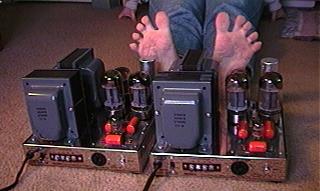
Wife Warming her toes on the MKIII's
The Dynaco Mark III is the highest power amplifier that was widely sold under the dyna name. There was a nigher power amp (the Mark VI), but it wasn't widely available. The Dyna MKIII has a basic design flaw that none of the other Dynaco products have. The capacitors in the power supply are not rated at a high enough voltage for the power transformer. This results in the quad cap being run over it's rated voltage every time the amp is turned on. The first section of the original quad cap is rated at 525 volts and the B+ goes as high as 585 volts during start up. This is due to the fact that the rectifier heats up and begins conducting before the power tubes heat up and start drawing power from the high voltage supply. The capacitor fatigue due to this over-voltage problem just get's worse with age, and to make matters worse, there isn't any 525 volt can caps available anymore. The amplifier doesn't have much room underneath to add a large capacitor bank either.
I have devised a printed circuit board that bolts directly under the output transformer without having to move any parts. It can be mounted in place using longer 8-32 bolts and a couple stand-offs or using the original transformer bolts and 8-32 threaded stand-offs. The circuit board uses 8 capacitors, with pairs in series to replace the quad cap. There are voltage equalizing resistors to keep the voltage across each cap equal. There is also provisions on the board for using silicon diodes instead of the 5AR4 rectifier (although I would recommend keeping the tube rectifier). There is also provisions on the board for film capacitor bypass for each of the 4 banks of capacitors. Without the film caps installed the capacitor board can handle B+ voltages up to 800 volts. With the film caps in place the board can handle voltages up to 630 volts. All of the parts for this board are available from Digi-Key, and the total cost is less than the replacement can cap for the ST-70.
Photos of the board installed in the MKIII can be seen in the Acrobat file below.
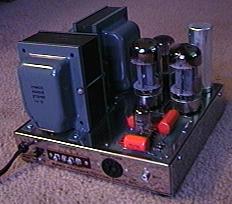
![]() Dyna MKIII Quad Capacitor
Replacement Board
Dyna MKIII Quad Capacitor
Replacement Board
Fisher SA-16 Amp
This next goodie is a vintage Avery Fisher power amp. It's from a console, but don't let that fool you, it's a fantastic amp! It uses one 12AX7 and a pair of EL84's per channel to produce about 15 watts. And it's some of the best 15 watts I've heard. One of my current favorites for the original Quad ESL's It's called the SA-16.
![]() Fisher SA-16 schematic (98 K)
Fisher SA-16 schematic (98 K)
My Fisher SA-16 Photo (122 K)
Heathkit UA-1 (or UA-2 or AA-61)
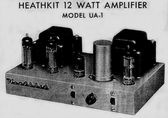
This is a small mono power amplifier. It uses a pair of EL84 (6BQ5) output tubes running in Ultralinear mode. It uses a 6AN8 as the input and phase splitter, and a EZ81 (6CA4) as the rectifier. This little amp was quite an eye opener for me. It has fantastic output transformers, I'm talking just plain amazing. The amp's -3 dB points are at 8 Hz and 65 KHz at full power. Plus the Square wave response at 20 Hz (5 watts) is very clean, it looks like there isn't a transformer there at all. After all the most critical part of all tube amps are the output transformers. These transformers (I believe that they were made by Chicago Standard), are larger than the transformers that are on the VTL 50/50 amp, but this amp is only rated for 12 watts! The amp was originally designed with two feedback schemes. The first is the traditional voltage feedback scheme, where some of the output signal is taken from the 16 ohm tap on the output transfomer, and fed back into the cathode of the input pentode. The amp sounds amazing in this mode. The second scheme uses some current feedback as well as voltage feedback. With this second scheme, the current from the speaker is senced via a small value resistor and fed back into the cathode of the input stage. The voltage feedback from the output of the amp is reduced by about half to keep the total feedback about the same. This may have worked well with old speakers, but doesn't sound very good with my Mission bookshelf speakers. And it sounds just awful with the Quad ESL's. You can flip a switch on the front of the amp to select either the great sounding traditional all voltage feedback, or the bad sounding current/voltage feedback scheme. When I rebuilt these amps, I removed that feature completely from the amp, and used the voltage feedback scheme. I'd say that this amp is a real sleeper, and you should buy a pair of them if you get the chance. The UA-1 and UA-2 amps are essentially idential. The only difference between the UA-1 and UA-2 are that Heath increased the value of the cathode resistor on the output tubes because the were running them WAY too hot, and burning them out quickly. The UA-1 had a 130 ohm resistor in the cathode at first. They changed that pretty quickly though, and the schematic here reflects that change. They also reduced the value of the screen grid resistor on the input stage to 680 K ohms. I have tried both the 1 meg and 680 K resistor and there is no difference that I can hear or measure. The AA-61 is a cosmetic change, Heath went from a gold colored chassis with a raised plastic "Heathkit" logo to a black chassis with a painted on logo. I have a pair of the AA-61's.
This amp slightly edges out the Fisher SA-16 as my favorite for the Quad ESL's.
Harman Kardon Citation II Amplifier
This 70 pound chocolate colored behemoth, designed by Stewart Hegeman is quite a feat of engineering. It's impressive weight and construction is equally matched by the impressive looking line of tubes, and the conservative 60 WPC power rating. But the really impressive work is "under the hood". Hegeman felt that a good amplifier should not be bandwidth limited to the audible range, but should extend farther in both extremes, so the amplifier can handle the audible range without any of the artifacts of limited bandwidth amplifiers; such as phase shift at the frequency extremes.
This amplifier consists of a pentode input stage, followed by a pair of pentodes as a differential phase splitter. The pentodes Hegeman chose were 12BY7 video pentodes. This choice of tube gives the input stage a bandwidth of well over a megahertz. The output tubes are a pair of KT88's per channel. There is a individual bias controls for each output tube as well as an AC balance control. There is a meter on the back of the amp to measure bias and AC balance. AC balance requires a set of 25 Watt 16 ohm dummy loads be substituted for the speakers. A test signal output RCA jack is supplied on the back of the amplifier. The test signal is fed into each channel and the AC balance pot is adjusted until the meter reads a null.
The output tubes drive a potted transformer which is arguably the best ever built. It was wound by Fleer in New York. It has a full power bandwidth of up to about 230 HKz. These transformers look like iron, but sound like gold. They are also scrounged by Bruce Moore for use in his MFA amplifiers. I'm sorry to say that many a Citation II has been gutted for it's iron.
There are three nested feedback loops. The first is from the plates of the phase splitter tubes, to their grids. The second is from the plates of the output tubes to the grids of the phase splitter tubes. The third is from the output transformer secondary to the cathode of the input tube. The total amount of feedback is about 32 dB. This about 10 dB more feedback than a traditional Mullard or Williamson type tube amp. The multiple loops, and fantastic output iron make this possible. The time constants of each loop have been carefully calculated. 10 KHZ square waves (at about 2/3 power) look amazingly good, with just a tiny hint of ringing (one period). This amplifier is amazingly stable for any tube amplifier, let alone a tube amp with that much feedback.
When the passive components in this amp are updated, this amp sounds just amazing. It produces music with an authority and an ease that is unequaled in the audio world. It tends to have a dry and "correct" sound rather than a "tube amp" sound. If you want the warmth and carmel sound of vintage tubes, this may not be the amplifier for you. If you want your music served up honestly with a bare minimum of distortion (and no solid state distortion), this may be the amp for you.
Note:This amp will Eat Quad ESL's, it sounds good, but can fry tweeters instantly
Harmon Kardon Citation II Schematic
VTL 50/50 Amp
The VTL 50/50 is a small stereo amp that uses a pait of 12AT7's and a Pair of Sovtek 5881/6L6GC output tubes per channel. It's a nice little entry level amp. Although the output transformers are a bit on the dismal side. I'd reccomend that you go for a ST-70, you'll be much happier.
Quad Electronics (The Classic Vacuum Tube Stuff)
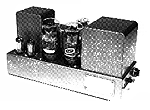
Quad II
Amplifier Schematic
Quad 22 Preamplifier Schematic
Beam-Echo Amplifier
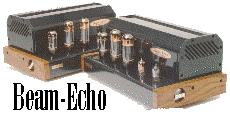
Beam-Echo is a British company founded in 1953. They created quite a few fine audio products under the Avantic name. They have just re-released a classic amplifier; the DL7-35. I really like this design, and may build or buy a pair of these someday. Check it out, it really looks good. Also check out their web page .
Beam-Echo
DL7-35 Schematic
Beam-Echo DL7-35 Parts List
Pass Zen Amp (from The Audio Amateur)
The folks at Pass Labs have designed a fantastic single ended transistor amp. It was written up in The Audio Amateur. And is also available at Pass' great Web site (see below). He also has some other great projects as well.
Pass Zen
Amp Schematic (GIF)
Pass Zen Parts List (GIF)
Pass Zen (Return of Zen) Amp Schematic
(GIF)
Misc Tube Amplifiers:
Fisher SA-100
Fisher 500C (508K)
Grommes 260A
Heathkit W5M
Marantz Model 5
Michaelson &Austin TVA-1